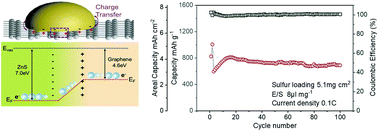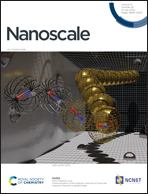Inducing rapid polysulfide transformation through enhanced interfacial electronic interaction for lithium–sulfur batteries†
Abstract
Sluggish dynamics of polysulfide (LiPS) conversion leads to reduced utilization of active sulfur and rapid capacity decay. Introducing catalysts into lithium–sulfur battery systems is a feasible and imperative strategy to tackle this problem. Previous research studies have mainly been focused on selecting new catalysts and design functional structures to improve performance, and ignoring the interaction between catalysts and their carriers. Herein, by simply fabricating a high-efficiency ZnS quantum dot@graphene nanosheet catalyst (ZnS QD@rGO), we utilized enhanced interfacial electronic interaction to accelerate polysulfide conversion for high energy density Li–S batteries. With the smaller size of ZnS, the interfacial electronic interaction becomes more enhanced, which was evidenced by DFT calculations and XPS experiments. After mixing with sulfur, the electrodes achieved a high capacity of 857.8 mA h g−1 at 1 C and a retention of 91.2% after 300 cycles. Also, a sulfur cathode with a high actual capacity of ∼4.0 mA h cm−2 could be obtained, with no obvious capacity decay within 100 cycles. We believe that this strategy represents a new perspective on designing efficient high-load electrodes for Li–S batteries.

- This article is part of the themed collections: Advanced Nanomaterials for Energy Conversion and Storage and 2020 Nanoscale HOT Article Collection


 Please wait while we load your content...
Please wait while we load your content...